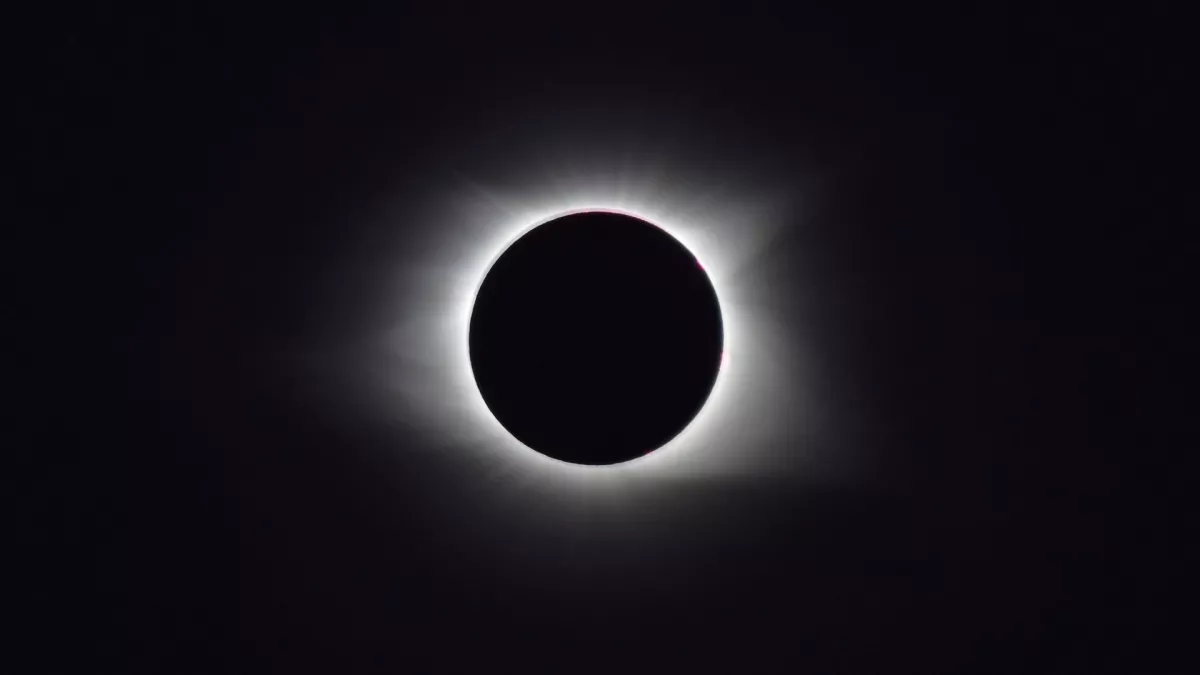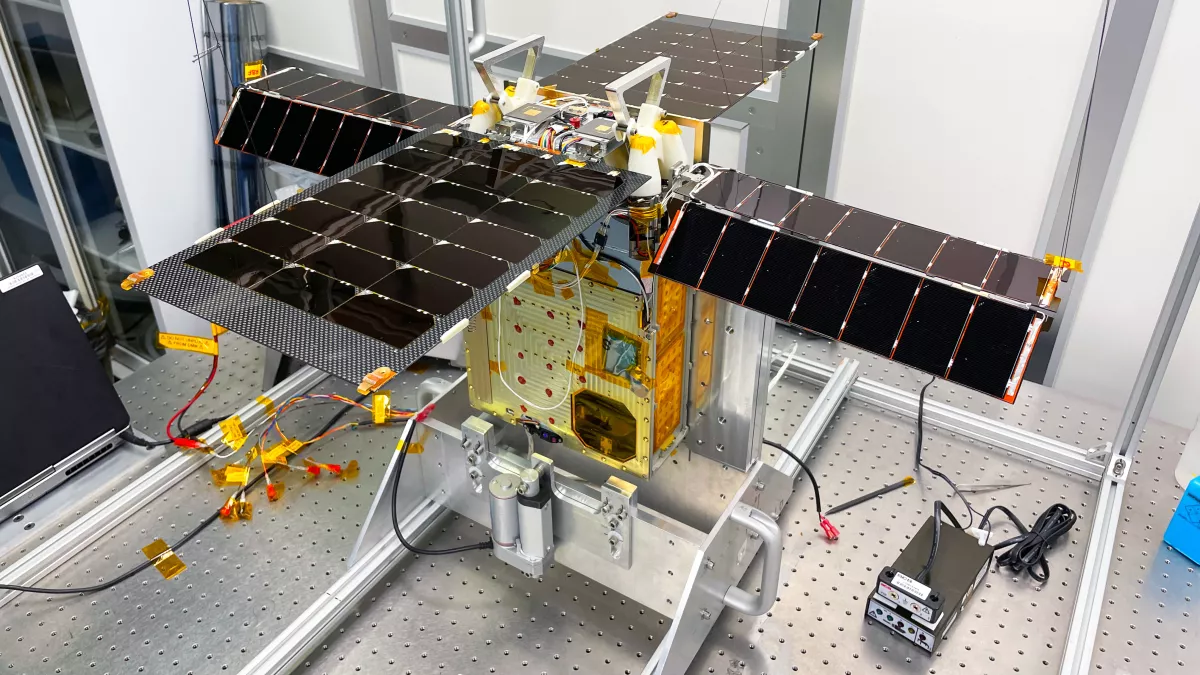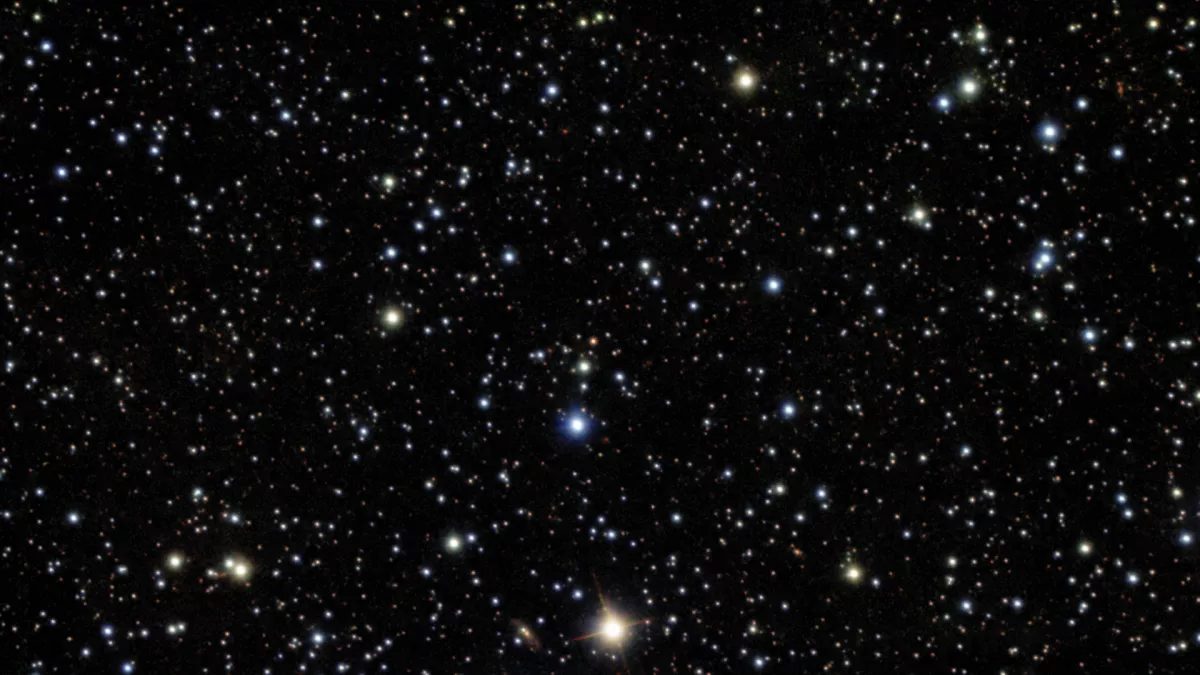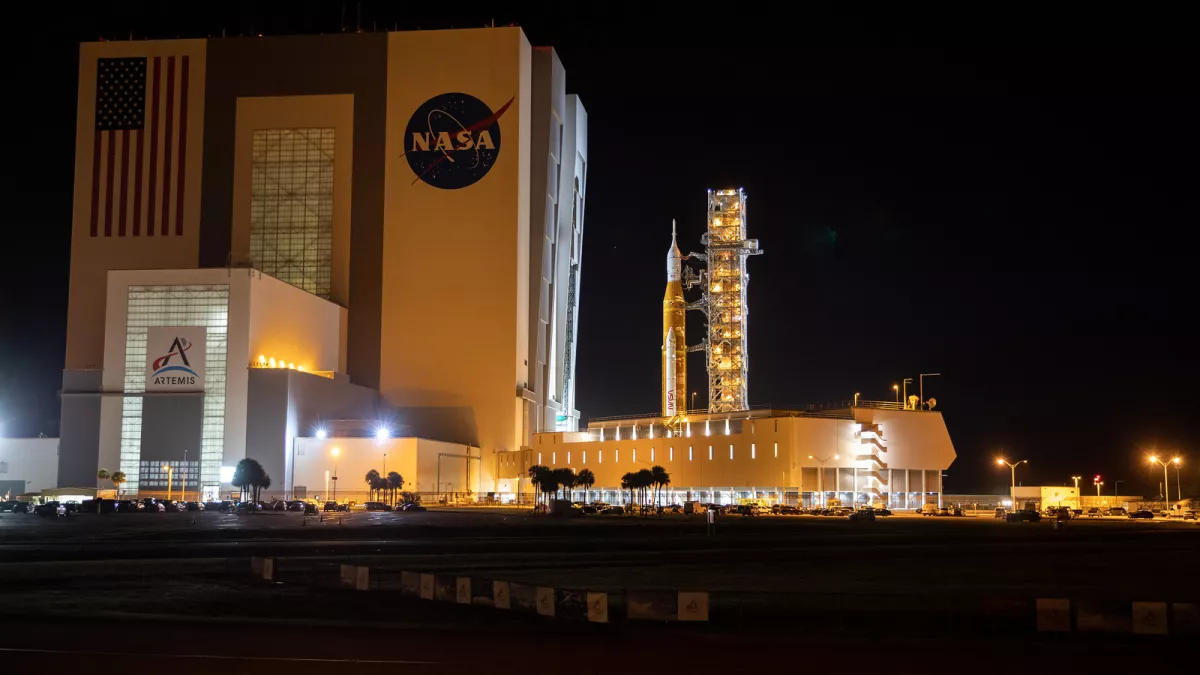A total solar eclipse and a 'ring of fire' make 2023 special for eclipse-chasers
February 14th, 2023

Have you ever seen a total solar eclipse? If you have, it's likely that you uttered the same thing as everyone else say after the experience — when's the next one?
Unfortunately, the last few total solar eclipses have been incredibly difficult to get to and were witnessed by relatively few eclipse-chasers. Not only is that set to change this year, but 2023 will have two very special solar eclipses. While the first solar eclipse is incredibly rare, the second is easily accessible to millions of North Americans.
Here's why 2023 is set to be an exciting one for anyone interested in solar eclipses.
A sight for sore eyes
The last time a total solar eclipse was experienced by whoever wanted to make the journey into the path of totality was on July 2, 2019, when a stunning eclipse was observed low in the late afternoon sky from northern Chile and Argentina. The long path of totality was mainly across the Pacific Ocean, only briefly crossing land just before sunset. The weather forecast had been very poor for the event, something that had persuaded many eclipse-chasers to wait until the following eclipse. That was a big mistake. As it turned out, the 2019 total solar eclipse was almost perfectly clear skies across South America with onlookers witnessing a dramatic totality low in the sky.
Sadly, particularly for those that stayed away, the 2019 total solar eclipse was the last time eclipse-chasers got to see the solar corona and Baily's beads—the two spectacular phenomena that make total solar eclipses so unique—for a few years.
The specter of COVID and its related stringent travel restrictions meant that the last two total solar eclipses were witnessed largely by domestic eclipse-chasers. On Dec. 14, 2020, many travel plans were axed and only local people — this time in southern Chile and Argentina — got to experience totality. Exactly a lunar year later on Dec. 4, 2021, only a few thousand people, mainly in cruise ships in Antarctica and some in a special eclipse flight — got to experience totality … as well as a few thousand Emperor penguins.
What about 2022? Sadly, there were no total solar eclipses for anyone to travel to — just a couple of partial solar eclipses observed (again) in Chile and Argentina on April 30, 2022 then in Europe on October 25, 2022.
US shoots down UFOs over Lake Huron and Canada
February 14th, 2023
The U.S. shot down a UFO over Lake Huron on Sunday, while Prime Minister Justin Trudeau said the U.S. shot down an unidentified flying object over the Yukon, Canada at his request.

An unidentified flying object (UFO) was shot down over Lake Huron in Michigan on Sunday (Feb. 12) — the fourth such object detected over the U.S. in a little over a week.
The flying object, which reports suggest was octagonal in shape and had strings hanging off of it, was first spotted over Montana on Saturday (Feb. 11) and then on Sunday, it migrated across the skies of Wisconsin before an F-16 shot it down over the lake in Michigan, officials said.
Just a day earlier, a fighter jet with the North American Aerospace Defense Command (NORAD), which is run by both the U.S. and Canada, shot down the strange object at the behest of Canada, Trudeau said, according to The New York Times(opens in new tab).
"I ordered the take down of an unidentified object that violated Canadian airspace," Trudeau wrote on Twitter(opens in new tab).
Canada is now in the process of recovering the wreckage to determine its origin and nature. Reports suggest it was cylindrical in shape and unlikely to be a balloon, according to The New York Times(opens in new tab).
This is the third time in a few days that a strange object has been shot down after entering U.S. airspace. Another object was detected entering U.S. airspace around 9 p.m. Alaska time on Thursday (Feb. 9) and the U.S. government subsequently sent a surveillance plane to track it. The object was flying between 20 and 40 mph (32 and 64 km/h) at an altitude used by civilian aircraft.
It crisscrossed land over Alaska before heading out to sea. It was flying toward the North Pole when it was shot down over the Arctic Ocean off the coast of Canada, John F. Kirby, a spokesman for the National Security Council, said in a news briefing on Friday (Feb. 10). Thus far, the U.S. does not see evidence that that object posed a military threat, officials said.
NASA water-hunting moon cubesat ready to launch with SpaceX
November 15th, 2022
The spacecraft was originally booked to fly on NASA's Artemis 1 mission.

NASA is going all in on the moon, and an upcoming mission called Lunar Flashlight will add lasers to the party.
During the mission, a small satellite (SmallSat), roughly the size of a briefcase, will skim the moon's surface and use lasers to peer into lunar craters, searching for water ice in places we haven't been able to explore yet. Lunar Flashlight will launch no earlier than Nov. 22 aboard a SpaceX Falcon 9 rocket rideshare, joining Japan's Hakuto-R lander and the United Arab Emirates' Rashid 1 rover.
"We are going to make definitive surface water ice measurements in permanently shadowed regions for the first time," Barbara Cohen, Lunar Flashlight principal investigator at NASA's Goddard Space Flight Center in Greenbelt, Maryland, said in a statement. "We will be able to correlate Lunar Flashlight's observations with other lunar missions to understand how extensive that water is and whether it could be used as a resource by future explorers."
Lunar Flashlight was originally due to ride along on NASA's Artemis 1 mission, flying on a massive Space Launch System (SLS) rocket currently targeting launch early on Wednesday (Nov. 16). However, the satellite missed the deadline for integration onto that spacecraft, prompting a search for a new launch vehicle.
Once launched, Lunar Flashlight will take approximately three months to reach the moon. Then, it will enter a near-rectilinear halo orbit, which is far less fuel-intensive than other orbits; because of the SmallSat's diminutive size, it cannot carry much propellant. (NASA's CAPSTONE mission, which arrived at the moon Sunday, Nov. 13, will use the same type of orbit for the same reason.) At the farthest point in its orbit, Lunar Flashlight will be 42,000 miles (68,000 kilometers) from the moon and, at its closest, just 9 miles (14 km) above the lunar surface.
The SmallSat will be the first satellite to use a new type of propellant: a more environmentally friendly monopropellant called Advanced Spacecraft Energetic Non-Toxic (ASCENT) that uses a catalyst rather than an oxidizer to burn. ASCENT is safer to store and transport than the more commonly used propellant hydrazine, which is extremely toxic to humans and can cause severe damage to the body.
"This is an exciting time for lunar exploration," Roger Hunter, Small Spacecraft Technology program manager at NASA's Ames Research Center in California, said in the statement. "The launch of Lunar Flashlight, along with the many small satellite missions aboard Artemis 1, may form the foundations for science discoveries as well as support future missions to the moon's surface."
Most powerful gamma ray burst ever seen could help reveal how black holes are born
October 17th, 2022
"We're just really in awe of this event and feeling very lucky to be able to study it."

All eyes are on the source of the record-breaking gamma ray burst that lit up the sky last week.
On Oct. 9, a beam of light more energetic than astronomers had ever seen zipped past our planet, temporarily blinding detectors on several NASA satellites. The beam came from a gamma ray burst, the most energetic type of explosion known to occur in the universe (apart from the Big Bang), which is believed to accompany the birth of some black holes.
Within hours, dozens of telescopes all over the world were pointing in the direction of the burst's source, confirming that this, indeed, was one for the books. The event, officially named GRB221009A, has since earned the nickname BOAT ("brightest of all time"), and astronomers hope it will help shed light on the mind-boggling physics behind these cataclysmic phenomena.
"It's a once in a century event, maybe once in 1,000 years," Brendan O'Connor, an astronomer at the University of Maryland and George Washington University, told Space.com. "We're just really in awe of this event and feeling very lucky to be able to study it."
How to watch NASA's Artemis 1 moon mission briefings and Megarocket rollout this week
August 15th, 2022
Three NASA Artemis 1 teleconferences and a megarocket rollout webcast will showcase the moon mission from Aug. 15 to Aug. 18.
NASA's Artemis 1 moon mission is poised to launch a new era of U.S. lunar exploration this month. You can learn the science behind the flight (and watch its towering rocket head to the launch pad) in a series of webcasts this week.
Artemis 1 is an uncrewed test flight of massive Space Launch System (SLS) megarocket and its Orion spacecraft, which NASA will use for crewed flights to the moon later this decade.
The planned launch date for Artemis 1 is Aug. 29, with Sept. 2 and Sept. 5 as backup days. The rocket will roll to its pad on Tuesday (Aug. 16), which you'll be able to watch online for free on this page, as well as via NASA's website(opens in new tab), NASA TV and the NASA app(opens in new tab).
NASA's Artemis 1 moon megarocket faces final test before rolling out for launch
August 15th, 2022

NASA engineers are testing the Space Launch System moon rocket's flight termination system ahead of rollout.
Engineers are testing a system designed to destroy NASA's massive Space Launch System moon rocket in case of problems with its impending launch.
Last week, NASA worked to certify the critical flight termination system (FTS) on the Space Launch System rocket, or SLS, which marks the final test before the megarocket rolls out to the pad later on Tuesday night (Aug. 16) Launch Complex 39B at Kennedy Space Center (KSC) in Florida, according to a NASA update(opens in new tab).
The FTS test is required by Space Launch Delta 45, a U.S. Space Force unit that operates the Eastern Range(opens in new tab). The system would be used to terminate the flight if necessary for safety reasons.
The Space Launch System rocket is due to send an uncrewed Orion spacecraft around the moon and back on what is the Artemis 1 mission. The first launch window is scheduled for Aug. 29. Backup launch windows are set for Sept. 2 and 5. N
Artemis 1 is an uncrewed test flight designed to test the Orion space capsule and SLS rocket for eventual crewed flights to the moon. If all goes well, NASA will follow it with a crewed Artemis 2 flight around the moon in 2024 and the crewed Artemis 3 moon landing mission around 2025, agency officials have said. The project is part of NASA's Artemis program to return humans to the moon and eventually aim for Mars.
But first, the Artemis 1 SLS needs to complete its FTS certification so it can launch. NASA received an extension from Space Launch Delta 45 on Aug. 12 for the certification of the FTS to cover 25 days instead of 20. This means the FTS certification—required by the Eastern Range to be tested 15 days before launch—will now also cover the Sept. 5 window.
Watch NASA's next-generation lunar Gateway space station build up in concept video
August 9th, 2022
Like a celestial Lego set, a new NASA video shows parts of a lunar station coming together.
Gateway, a space station which will support the Artemis human missions to the moon, will require several assembly missions, shown in detail in a new YouTube video( from the NASA Johnson Space Center.
The new moon-orbiting station will host crews only occasionally, making it distinct from the International Space Station (ISS) that has hosted crews continuously since 2000. But both stations share the capability of rapid assembly by astronauts and machines.
As seen in the video, Gateway's tenure will begin with a power and propulsion element, supplied by Maxar Technologies, docking with a habitation and logistics outpost from Northrop Grumman. Following these, the first crew will come, along with a European Space Agency-supplied I-Hab (habitat module).
The video then shows the sequence of human missions and other elements that will be arriving on the space station, notably including the Canadarm3 robotic arm from the Canadian Space Agency, built by MDA.
Gateway will be used as a supply station for missions to the moon, although NASA has removed it from the "critical path" for the very first missions.
The first mission in the Artemis series, an uncrewed test flight dubbed Artemis 1, will blast off as soon as Aug. 29. Artemis 2, a moon-orbiting mission with humans, is scheduled for 2024 and Artemis 3, a crewed landing mission, no earlier than 2025.
Stunning James Webb Space Telescope image shows stars forming in strange wheel-shaped galaxy
August 2nd, 2022
By
Webb sees through dust and gas into regions out of reach of optical telescopes such as Hubble.
The James Webb Space Telescope peered through dust and gas to reveal star formation in a rare wheel-shaped galaxy that formed in a long-ago galactic crash.
The galaxy, called the Cartwheel for its striking resemblance to a wheel of an old fashioned carriage, was previously studied by the Hubble Space Telescope, but Webb's infrared gaze has revealed a plethora of previously unseen details in the galaxy's structure.
Infrared light, which is essentially heat, penetrates through dust clouds, allowing the James Webb Space Telescope to peer into regions of space that are obscured to optical telescopes, such as Hubble. In the new images, Webb instruments NIRCam and MIRI, revealed individual stars within the star-forming regions in the outer ring of the Cartwheel galaxy, as well as clusters of very young stars around the galaxy's central supermassive black hole, which is also shrouded in dust.
The Cartwheel, located about 500 million light-years away from Earth in the constellation Sculptor in the southern sky, is a rather rare type of galaxy that astronomers call a ring galaxy. Scientists believe that long ago, the Cartwheel was a common spiral galaxy, similar to our Milky Way. Then, about 700 to 800 million light-years ago, it collided with a smaller galaxy.
The crash altered its shape and structure to what astronomers can see today, forming two ring-like structures, one surrounding the galactic center and another framing the entire galaxy. The two rings expand outward from the galaxy's center like "ripples in a pond," the Space Telescope Science Institute (STScI), which operates Webb and is based in Maryland, said in a statement(opens in new tab).
As the outer ring expands, it pushes outward the dust and gas that surrounds the galaxy and triggers star formation, according to STScI. The areas where new stars are being born appear as small blue dots in the image and are scattered throughout the galaxy, but especially concentrated in the outer ring.
The Cartwheel, located about 500 million light-years away from Earth in the constellation Sculptor in the southern sky, is a rather rare type of galaxy that astronomers call a ring galaxy. Scientists believe that long ago, the Cartwheel was a common spiral galaxy, similar to our Milky Way. Then, about 700 to 800 million light-years ago, it collided with a smaller galaxy.
The crash altered its shape and structure to what astronomers can see today, forming two ring-like structures, one surrounding the galactic center and another framing the entire galaxy. The two rings expand outward from the galaxy's center like "ripples in a pond," the Space Telescope Science Institute (STScI), which operates Webb and is based in Maryland, said in a statement(opens in new tab).
As the outer ring expands, it pushes outward the dust and gas that surrounds the galaxy and triggers star formation, according to STScI. The areas where new stars are being born appear as small blue dots in the image and are scattered throughout the galaxy, but especially concentrated in the outer ring.

NASA picks SpaceX's Falcon Heavy rocket to launch Roman Space Telescope
July 20th, 2022
The reusable heavy-lift rocket will launch the new space telescope in 2026, NASA says.
NASA's forthcoming dark matter-hunting telescope has a ride on a SpaceX rocket.
The Roman Space Telescope will launch no earlier than 2026 aboard a Falcon Heavy rocket from the California-based company, NASA announced(opens in new tab) Tuesday (July 19).
NASA will pay SpaceX $255 million for the launch service "and other mission-related costs," agency officials stated. The mission is slated to launch from Launch Complex 39A at NASA's Kennedy Space Center in Florida.
While Falcon Heavy is a largely new rocket — it has only launched three times, most famously with a Tesla-riding mannequin on board in 2018 — it appears the agency wanted the extra fuel this rocket can carry, over SpaceX's lighter-lift Falcon 9 workhorse.
That's because Roman will be flying to a distant orbit known as Lagrange 2, or L2, which is about 930,000 miles (1.5 million kilometers) away from our planet. This orbit, which the James Webb Space Telescope also shares, is relatively far away from Earth and as such, requires extra fuel to fly there directly.
Working in infrared light, Roman is scheduled to undertake investigations into dark energy and dark matter that are believed to make up much of the structure of the universe.
The telescope will also examine exoplanets using a technique called microlensing, examining subtle "warps" in space-time induced by planets circling their parent stars.
NASA has said wide-field the telescope will be a valuable surveyor of exoplanets to scout for worlds that Webb can see in higher-definition, and that are farther away from Earth than what the Transiting Exoplanet Survey Satellite (TESS) could pick up.
NEW MAP OF THE NIGHT SKY REVEALS 4.4 MILLION GALAXIES AND OTHER SPACE OBJECTS
February 28th, 2022

1st image from NASA's new IXPE X-ray telescope looks like a ball of purple lightning
February 15th, 2022

NASA's newly-launched X-ray hunting probe has snapped its first science image and — wow — it's spectacular.
The Imaging X-ray Polarimetry Explorer (IXPE) probe launched Dec. 9, 2021, on a mission to observe objects like black holes and neutron stars in X-ray light, shedding much-anticipated light on the inner workings of the cosmos. The probe spent its first month in space checking out its various systems to get ready to capture its first images, and now the IXPE team has released its very first science image.
The image shows Cassiopeia A, the remnants of a star that exploded as a supernova in the 17th century. That explosion sent shock waves outwards, heating up surrounding gasses and accelerating cosmic ray particles (high-speed electrons and atomic nuclei) to create a cloud of assorted matter, according to a statement from NASA. This cloud, as you can see in the striking image from IXPE, glows brilliantly in X-ray light.
It goes without saying that the image is visually stunning.
"The IXPE image of Cassiopeia A is bellissima, and we look forward to analyzing the polarimetry data to learn even more about this supernova remnant," Paolo Soffitta, the Italian principal investigator for IXPE at the National Institute of Astrophysics (INAF) in Rome, said in the NASA statement. ("Bellissima" means beautiful in Italian.)
Now, while the image's most striking feature is its almost-neon magenta color, it doesn't actually look like that in visible light. But this color, which represents X-ray radiation, is a helpful guide for scientists. The more saturated the color, the more intense the X-ray light. Additionally, veins of what resembles blue lightning in the image represent high energy X-rays seen by NASA's Chandra X-ray Observatory.
While the two telescopes both observe X-rays, they have different kinds of detectors so, by working together, they can produce more complete and detailed data, according to the statement.
Chandra's first image was also of Cassiopeia A after it launched all the way back in 1999. Chandra's early observations revealed that, at the center of the remnant, there must be a compact object like a black hole or neutron star.
1 year after launch, NASA's Perseverance rover prepares to collect 1st sample on Mars
July 30th, 2021
Grand Universe

WESTFIELD, Ind. — A massive development is being planned for Westfield, right next door to Grand Park. “Grand Universe” will be a state-of-the-art space center with the goal of encouraging young minds to pursue careers in science and technology.
The development is being led by Birch Dalton with EdgeRock Development, but the space center project is being launched by the Link Observatory Space Science Institute and their director Greg McCauley
“If you look right out there in the middle,” McCauley said as he pointed to an empty 55-acre plot of land, “right in the center of that field right there will be this magnificent 50,000 square foot footprint of this magnificent building.”
The massive space center will not only include the largest public planetarium in the state, but also thousands of square feet of exhibits and a massive observatory with 30-foot domes and telescopes named after Hoosier astronaut David Wolf.
“17 or 18 astronauts came from Purdue university, and yet Indianapolis remarkably is one of the largest metropolitan areas in the country that doesn’t have a space center,” McCauley said
Since the Challenger Learning Center in Brownsburg closed about seven years ago, Grand Universe will fill a void left in central Indiana, launching students into STEM careers.
“We have fallen behind in science and technology,” McCauley said. “We believe Grand Universe will help us again take that leap.”
Grand Universe hopes to attract young families who are in town for events at Grand Park, and also attract families from across the state. Westfield sees the project as another reason for people to visit the area.


